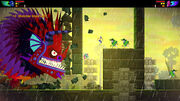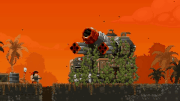
A boss fight from Guacamelee!, a game in the metroidvania genre, in which the player characters (the two characters in luchador outfits) must keep ahead of the giant rampaging creature (boss) on the left, while dodging obstacles and other enemies.
In video games, a boss is a significant computer-controlled enemy.[1] A fight with a boss character is commonly referred to as a boss battle or boss fight. Boss battles are generally seen at a climax of a particular section of the game, usually at the end of a level or stage, or guarding a specific objective; the boss enemy is generally far stronger than the opponents the player has faced up to that point, and is usually faced solo. A miniboss is a boss weaker or less significant than the main boss in the same area or level.. A superboss is generally much more powerful than the bosses encountered as part of the main game's plot and often optional to encounter. A final boss is often the main antagonist of a game's story and the defeat of that character provides ultimate satisfaction to the game player.
For example, in a combat game all regular enemies might use pistols while the boss uses a machine gun.[2]Template:Not in citation A boss enemy is quite often larger in size than other enemies and the player character.[3] At times, bosses are very hard, even impossible, to defeat without being adequately prepared and/or knowing the correct fighting approach. Bosses take strategy and special knowledge to defeat, such as how to attack weak points or avoid specific attacks.
Bosses are common in many genres of video games, but they are especially common in story-driven titles. RPGs, FPSs, platform games, and fighting games are particularly associated with boss battles. They may be less common in puzzle games, card video games, sports games, and simulation games. The first game to feature a boss fight was the 1975 RPG dnd. The concept has expanded to new genres, like rhythm games, where there may be a "boss song" that is more difficult.
History[]
The first interactive game to feature a boss was dnd, a 1975 role-playing video game for the PLATO system.[4][5] One of the earliest dungeon crawls, dnd implemented many of the core concepts behind Dungeons & Dragons.[5] The objective of the game is to retrieve an "Orb" from the bottommost dungeon.[6] The orb is kept in a treasure room guarded by a high-level enemy named the Gold Dragon. Only by defeating the Dragon can the player claim the orb, complete the game, and be eligible to appear on the high score list.[4]
A 1980 example is the fixed shooter Phoenix, wherein the player ship must fight a giant mothership in the fifth and final level.[7]
Characteristics[]
Bosses are usually more difficult than regular enemies, can sustain more damage, and are generally found at the end of a level or area.[8][9] While most games include a mixture of boss opponents and regular opponents, some games have only regular opponents and some games have only bosses (e.g. Shadow of the Colossus).[10] Some bosses are encountered several times through a single game, typically with alternate attacks and a different strategy required to defeat it each time.[9] A boss battle can also be made more challenging if the boss in question becomes progressively stronger and/or less vulnerable as their health decreases, requiring players to use different strategies to win. Some bosses may contain or be composed of smaller parts that can be destroyed by the player in battle, which may or may not grant an advantage.[citation needed] In games such as Doom and Castlevania: Order of Ecclesia, an enemy may be introduced via a boss battle, but later appear as a regular enemy, after the player has become stronger or had a chance to find more powerful weaponry.[citation needed]
Boss battles are typically seen as dramatic events. As such, they are usually characterized with unique music and cutscenes before and after the boss battle. Recurring bosses and final bosses may have their own specific theme music to distinguish them from other boss battles. This concept extends beyond combat-oriented video games. For example, a number of titles in the Dance Dance Revolution rhythm game series contain "boss songs" that are called "bosses" because they are exceptionally difficult to perform on.[11]
Specific boss types[]
Miniboss[]

Miniboss in the 2015 video game Broforce, a run-and-gun platformer
A miniboss, also known as a "middle boss", "mid-boss", "half-boss", "sub-boss",[12] or "semi-boss", is a boss weaker or less significant than the main boss in the same area or level. Some minibosses are stronger versions of regular enemies, as in the Kirby games.[citation needed] Other video game characters who usually take the role of a miniboss are the Koopalings (Super Mario series), Dark Link (The Legend of Zelda series), Vile (Mega Man X series), and Allen O'Neil (Metal Slug). There is also a subtype nicknamed the "Wolfpack Boss", for its similarity to a pack of wolves, often consisting of a group of strong normal enemies that are easy to defeat on their own, but a group of them can be as difficult as a boss battle.
Superboss[]
A superboss is a type of boss most commonly found in role-playing video games. They are considered optional enemies, though optional bosses are not all superbosses and do not have to be defeated to complete the game. They are generally much more powerful than the bosses encountered as part of the main game's plot or quest, more difficult even than the final boss, and often the player is required to complete a sidequest or the entire game to fight the superboss. For example, in Final Fantasy VII, the player may choose to seek out and fight the Ruby and Emerald Weapons. Some superbosses will take the place of the final boss if certain requirements are met. This is common in fighting games such as Akuma in Super Street Fighter II Turbo. Some superbosses can also yield special items or skills that cannot be found any other way that can give a player a significant advantage during playthrough of the rest of the game, such as added experience or an extremely powerful weapon. For example, the "raid bosses" from Borderlands 2 give rare loot unavailable anywhere else. Some superbosses in online games have an immense amount of health and must be defeated within a time limit by having a large number of players or parties working together to defeat the boss. Examples of such superbosses can be found in games like Shadow Fight 2 and Star Wars: Galaxy of Heroes.
Final boss[]
The final boss, or end boss,[13] is typically present at, or near, the end of a game, with completion of the game's storyline usually following victory in the battle.[14][15] The final boss is usually the main antagonist of the game; however, there are exceptions, such as in Conker's Bad Fur Day, where the final boss is the antagonist's alien pet. Final bosses are generally larger, more detailed, and better animated than lesser enemies, often in order to inspire a feeling of grandeur and special significance from the encounter.[citation needed]
In some games, a hidden boss, referred to as the "true" final boss, is present. These bosses only appear after the completion of specific additional levels, choosing specific dialogue options, or after obtaining a particular item or set of items, such as the Chaos Emeralds in the Sonic the Hedgehog series, or doing a series of tasks in Metal Gear Solid: Peace Walker. These bosses are generally more difficult to defeat. In games with a "true" final boss, victory leads to either a better ending, or a more detailed version of the regular ending. Examples of a "true final boss" include Indalecio in Star Ocean: The Second Story and the Moon Presence in Bloodborne.
Some reviewers, over the years, have harshly criticized the implementation of final bosses. A video game journalist known as "Scorpia" stated in 1994 that "about 98% of all role-playing video games can be summed up as follows: 'We go out and bash on critters until we're strong enough to go bash on Foozle.'"[14]
The term "Foozle" was used in the 1990s[14] to describe a cliché final boss that exists only to act as the final problem before a player can complete the game.[16][15]
References[]
- ↑ Burt, Andy (2008–4). "No More Heroes: The Killer Boss Guide". GamePro. vol. 235. p. 66.
- ↑ Thompson, Clive (8 May 2006). "Who's the Boss?". Wired. Archived from the original on 8 May 2008. Retrieved 2008-03-22.<templatestyles src="Module:Citation/CS1/styles.css"></templatestyles>
- ↑ Schroder, Ben (15 November 2006). "The Top 7... Big Bosses". GamesRadar+. Archived from the original on 8 March 2014. Retrieved 6 June 2013.<templatestyles src="Module:Citation/CS1/styles.css"></templatestyles>
- ↑ 4.0 4.1 "Gary Whisenhunt, Ray Wood, Dirk Pellett, and Flint Pellett's DND". Armory.com. Retrieved 2008-04-08.<templatestyles src="Module:Citation/CS1/styles.css"></templatestyles>
- ↑ 5.0 5.1 "dnd (The Game of Dungeons)". Universal Videogame List. Archived from the original on 13 November 2007. Retrieved 2008-04-09.<templatestyles src="Module:Citation/CS1/styles.css"></templatestyles>
- ↑ Barton, Matt (23 February 2007). "The History of Computer Role-Playing Games Part 1: The Early Years (1980–1983)". Gamasutra. Retrieved 2019-03-05.<templatestyles src="Module:Citation/CS1/styles.css"></templatestyles>
- ↑ Sterbakov, Hugh (5 March 2008). "The 47 Most Diabolical Video-Game Villains of All Time". GamePro. Archived from the original on 2008-03-09. Retrieved 2008-04-28.<templatestyles src="Module:Citation/CS1/styles.css"></templatestyles>
- ↑ Thompson, Clive (6 May 2004). "Tough Love: Can a video game be too hard?". Slate. Archived from the original on 10 February 2009. Retrieved 1 March 2009.<templatestyles src="Module:Citation/CS1/styles.css"></templatestyles>
- ↑ 9.0 9.1 "The Next Generation 1996 Lexicon A to Z". Next Generation (Imagine Media) (15): 30. March 1996.
- ↑ Roper, Chris (17 October 2005). "Shadow of the Colossus Review". IGN. Archived from the original on 31 May 2012. Retrieved 2014-11-18.<templatestyles src="Module:Citation/CS1/styles.css"></templatestyles>
- ↑ Dodson, Joe (15 October 2007). "Dance Dance Revolution: SuperNOVA 2 Review". GameSpot. Retrieved 2019-03-05.<templatestyles src="Module:Citation/CS1/styles.css"></templatestyles>
- ↑ "The Next Generation 1996 Lexicon A to Z: Sub-boss". Next Generation (Imagine Media) (15): 41. March 1996.
- ↑ Rossi, Matthew (13 June 2012). "Know Your Lore: The true end boss of Mists of Pandaria?". Engadget. Retrieved 20 June 2019.<templatestyles src="Module:Citation/CS1/styles.css"></templatestyles>
- ↑ 14.0 14.1 14.2 Scorpia (August 1994). "Scorpia The Avatar". Computer Gaming World (121): 29–33. http://www.cgwmuseum.org/galleries/index.php?year=1994&pub=2&id=121. Retrieved 21 November 2017.
- ↑ 15.0 15.1 Kaiser, Rowan (13 July 2010). "Stop Killing the Foozle!". The Escapist. Archived from the original on 22 December 2017. Retrieved 2017-12-20.<templatestyles src="Module:Citation/CS1/styles.css"></templatestyles>
- ↑ Scorpia (20 May 2009). "Looking Evil". Scorpia's Gaming Lair. Archived from the original on 7 April 2016. Retrieved 11 November 2018.<templatestyles src="Module:Citation/CS1/styles.css"></templatestyles>